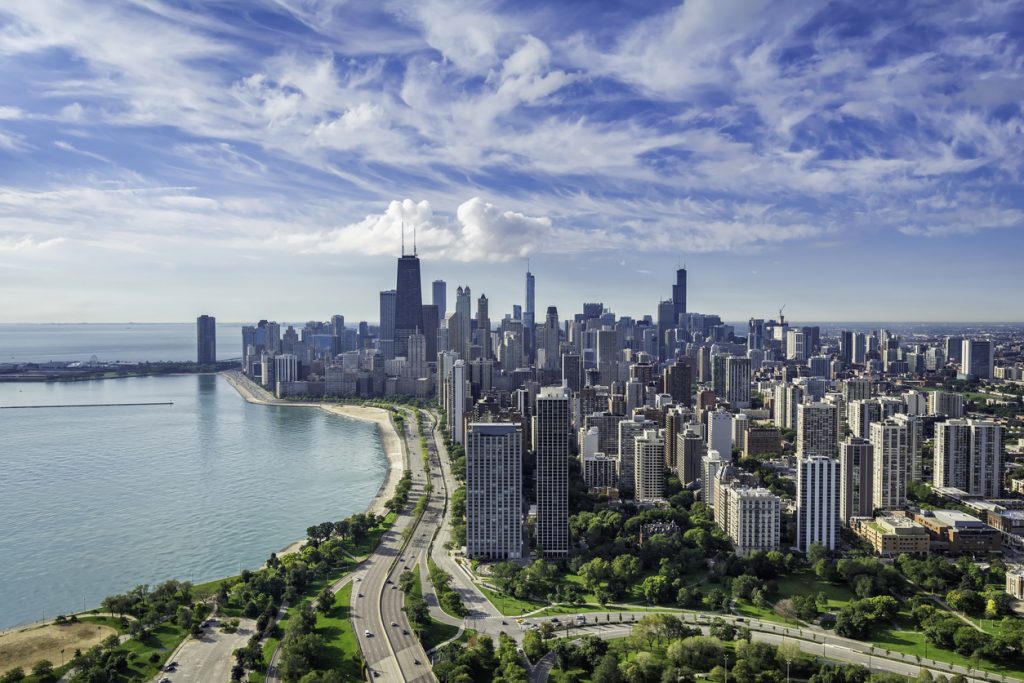The Windy City, the city of skyscrapers or simply Chicago. The third-largest city in the USA is located in the state of Illinois and attracts hundreds of thousands of tourists every year. Rivalling New York in popularity, it stands on the shores of Lake Michigan — and even has its own pizza, the famous Chicago-style deep-dish pizza with its extra thick crust. But there’s no doubt that the attraction that draws most visitors is the city’s skyscrapers, which create the sensation of being in a gigantic urban forest. We start out on our walk with legs numb from the intense cold, but it’s all going to be worth it.
Chicago’s first skyscraper was built in 1885. It was the Home Insurance Building, 42 metres high, with only ten storeys. It collapsed in 1931 – but was the inspiration for many more.
WILLIS TOWER
At 233, South Wacker Drive we come to Willis Tower, or Sears Tower, as older residents still refer to it. The tower was built in 1974 and remained the tallest building in the world until 1996. It offers stunning views of the city, and on the 103rd floor you’ll find the famous Skydeck, a glass platform 412 metres above the city, not recommended for those who suffer from vertigo.

TRUMP TOWER
The second-tallest skyscraper in Chicago was already world famous, but its popularity has increased since the US presidential election was won by its owner, Donald Trump, who uses the penthouse suite as a private residence. Situated at 725, Fifth Avenue, it is 423 metres high. Building work began in 2001 and it was planned to be the tallest skyscraper in the USA. However, after the terrorist attack of 9/11, stricter security regulations meant that its height had to be restricted. All the same, the views out over Lake Michigan are impressive.

AON TOWER
At 346 metres high it is the third-tallest skyscraper in the city. Originally clad in marble, during the 1990s it was refaced in granite because the marble slabs had begun to deteriorate and break away from the building. It is exclusively used as office space and in recent years has been lit in orange for Thanksgiving, green for Christmas and pink for Breast Cancer Awareness Day.

JOHN HANCOCK OBSERVATORY
On North Michigan Avenue, at number 875, we come to the fourth-highest skyscraper in Chicago. It is 344 metres high and boasts a trapezoid facade that makes it easily recognisable. On the 94th floor there’s a glass observation deck for the bravest visitors, whose floor to ceiling windows tilt outwards once you are inside – up to eight people can enjoy the experience at a time. Again, not recommend for the faint-hearted.
After enjoying the views from these architectural wonders, a visit to one of the city’s impressive parks is a must. My own pick is the most famous of all, Millenium Park, in the Loop community area, a green space that covers an area of almost 10,000 square metres. It is the venue for countless events and shows throughout the year, and offers the chance to see many works of art and architecture.

Inside the park you can visit the Jay Pritzker Pavilion, a state of the art venue that can seat 4000 people, and the Cloud Gate, an enormous bean-shaped blob of stainless steel in which nearby skyscrapers are reflected. It’s an original work that is 20 metres wide and weighs 100 tonnes.
The park is fun all year round, but it’s only in winter that you’ll catch a scene familiar from the movies: families skating round the McCormick Tribune Plaza ice rink. During the rest of the year it’s a popular destination for picnics and other outdoor activities.
After spending a few days in the Windy City, the first-time visitor starts to realise that the city is worth a return trip – and leaves with the feeling that there’s still much more to be seen.







